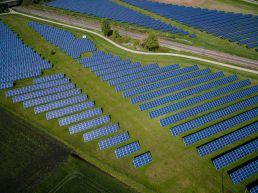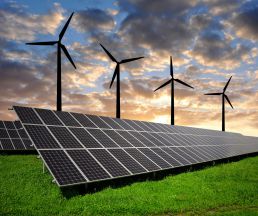Sustainability
What Is Sustainable Investing?
Sustainability – a company’s ability to create positive environmental and societal impact – is rapidly reshaping the corporate landscape. It is reshaping whole industries and generating new waves of growth.
The staggering scale of the disruption (and opportunities) that will play out over the next few decades are why many company executives right now are strategizing as to how to position their companies for the future in the face of ongoing megatrends, such as climate change.
More and more governments, as well as corporations, are pledging to back a United Nations campaign aiming for net-zero greenhouse gas emissions. This will affect how nearly every company operates.
Just the push to limit global temperature increases to under 2°C—the number one sustainability challenge of our time—will drive a massive transformation of the global economy. It will require investments totaling an estimated $100 trillion to $150 trillion by 2050.
Tomorrow’s best companies will be those that can operate outside of their comfort zone. Why? At its core, sustainability has a lot to do with resiliency.
Companies must build the capacity to adapt and innovate amid worldwide disruptions. In effect, sustainability requires “unlearning” how industrial society has operated for 150 years, and charting a new route to reach the same goal of delivering shareholder value.
Going forward, C-suite executives and boards must treat social responsibility and environmental stewardship not as separate functions largely disconnected from strategy, but rather as integral to corporate and business strategy.
Differences Between Sustainable Investing, Socially Responsible Investing, & ESG Investing
Sustainable Investing, Socially Responsible Investing (SRI), and ESG Investing are often used interchangeably. However, these investment approaches are each different.
Sustainability has become a catch-all term for a company’s efforts to “do better” or “do good.” This investment approach has three basic pillars: economic growth, environmental protection, and social progress. At times, this is referred to as “people, planet, and profits.” In a nutshell, sustainable investing directs capital to companies fighting climate risk and environmental destruction, while also promoting corporate responsibility.
In general, SRI investors encourage corporate practices that are morally grounded and promote environmental stewardship, consumer protection, human rights, and racial/gender diversity. Essentially, for socially responsible investors, morality trumps the bottom line.
ESG investing also focuses on three pillars. Environmental issues, which can include pollution, climate change, extreme weather, carbon management, and use of scarce resources. Social issues, which can include product safety, human rights, worker safety, customer data protection, and diversity and inclusion. Governance issues, which can include factors such as accounting standards compliance, anti-competitive behavior, and a strong ESG management process.
ESG data and metrics are used to gain insights into the success and value of a company’s performance and policies in order to mitigate risk and identify superior risk-adjusted returns. Essentially, the focus of ESG investing is on increasing the bottom line through investments in responsible companies that are being well managed.
Why Choose Sustainable Investing?
This type of investing has become Wall Street’s hottest growth area.
According to data supplied by The Forum for Sustainable and Responsible Investing, there are nearly $13 trillion invested into some form of socially responsible investing. And according to research conducted by Morgan Stanley in 2019, 85% of individual investors and 95% of millennial investors are interested in sustainable investing.
Sustainable investing makes a lot of sense, even if your only concern is the return on the money you are investing.
Like the tortoise in the fabled race with the hare, long-term investors are seeing growing evidence that this type of investing can beat traditional methods. For example, in the past few years, companies with higher ESG ratings had higher average return on invested capital, compared to companies with lower ratings, according to MSCI.
The reason for this outperformance is straightforward and obvious… ESG pushes companies to look beyond the next quarter or even the next three- to five-year business cycle in evaluating risk.
Even the results from the tough first half of 2020 were good. Morningstar said, “an impressive 72% of sustainable equity funds rank in the top halves of their Morningstar categories and all 26 ESG (environmental, social, and governance) index funds have outperformed their conventional index-fund counterparts.”
How to Participate in Sustainable Investing
With the large number of companies touting their sustainability credentials, you would need a ‘scorecard’ to keep track. A much easier route would be to purchase ETFs or mutual funds that invest in companies with specific sustainability goals. A simple search on Magnifi indicates numerous ways for investors to access sustainable funds with low fees.
Unlock a World of Investing
with a Magnifi Account
Magnifi is changing the way we shop for investments, with the world’s first semantic search engine for finance that helps users discover, compare and buy investment products such as ETFs, mutual funds and stocks. Open a Magnifi investment account today.
The information and data are as of the November 8, 2021 (publish date) unless otherwise noted and subject to change. This blog is sponsored by Magnifi.
Socially Responsible Investing (SRI)
What is Socially Responsible Investing (SRI)?
One of the biggest changes ever in the investment landscape has been the move in recent years to Socially Responsible Investing (SRI). While the concept may have begun in our country as an activity associated with religious societies – the Quakers not participating the slave trade – it has evolved immensely since. It is now a mainstream practice being embraced by both individuals and corporations.
Gone are the days when investors solely focused on factors such as diversification, investment income, rate of return, inflation, taxes and risks. Nowadays, socially responsible investors are going one step further. They are also choosing to factor in whether a particular investment positively impacts society.
In other words, socially responsible investment works the same way as any style of investing. But in addition to the financial returns from an investment, it also considers the investments’ impact on environmental, ethical or social change.
It enables you – the investor – to grow your money while doing good. And it allows you to invest in social causes you care about.
Why Choose Socially Responsible Investing?
Who wouldn’t want a great way to boost their assets while also making a difference? That’s what SRI does.
Socially responsible investments seek to maximize the welfare of people and their environment while earning a return on one’s investment that is consistent with your individual goals. In simple terms, the twin goals of socially responsible investing are: social impact and financial gain.
Some question whether a do-good investment strategy can perform as well as standard investing strategies. The answer is yes.
A 2020 research analysis from the asset management firm Arabesque Partners found that 80% of the reviewed studies demonstrated that sustainability practices have a positive influence on investment performance.
Several other studies have shown that SRI mutual funds can not only match traditional mutual funds in performance, but they can sometimes perform better. There is also evidence that SRI funds may be less volatile than traditional funds.
Even today, there are some that have doubts about socially responsible investing. Opponents have argued that by narrowing the field of investment options (such as avoiding weapons makers, gambling and tobacco stocks), the end result is a narrowing of investment returns.
But now, there is a growing body of evidence (in addition to the aforementioned studies) that shows the opposite is true: SRI not only makes you feel good, but it’s also good for your portfolio.
What’s the Difference Between SRI and ESG Investing?
While at first glance, both SRI and ESG (Environmental, Social and Corporate Governance) investing look at a company’s broader impact, there are some distinct differences between the two.
First off, SRI investing is not as well defined as ESG investing. SRI is more subjective and based on an individual’s view of the world – political views, what is right and wrong, and what is ethical, etc.
In contrast, ESG investments are measured by and scored on specific environmental, social and governance metrics. More specifically, ESG investing looks at specific factors, such as a company’s best practices when it comes to pollution or women’s rights.
SRI, on the other hand, takes these factors into account and blends them with an investor’s personal values.
Bottom line: SRI involves screening investments to exclude businesses that conflict with the investor’s values. While ESG investing focuses on companies making an active effort to either limit their negative societal impact or deliver benefits to society (or both).
How to Participate in Socially Responsible Investing?
You have a number of options available to you if you want to invest in good causes. You can make socially responsible investments via individual stocks. However, the better (and safer) bet is to do so through socially conscious mutual funds and exchange-traded funds (ETFs). A simple search on Magnifi indicates numerous ways for investors to access SRI funds with low fees.
Unlock a World of Investing
with a Magnifi Account
Magnifi is changing the way we shop for investments, with the world’s first semantic search engine for finance that helps users discover, compare and buy investment products such as ETFs, mutual funds and stocks. Open a Magnifi investment account today.
The information and data are as of the May 28, 2020 (publish date) unless otherwise noted and subject to change. This blog is sponsored by Magnifi.
Wind Energy
Unlock a World of Investing with a Free Magnifi Account
While wind energy as a reliable and standard resource may seem far off, the technology is being adopted at record speed. In fact, wind energy is one of the fastest-growing energy sources in the world, according to the U.S. Department of Energy.
That’s especially true for 2020, a banner year for the wind industry, according to a report by American Clean Power (ACP).
In the fourth quarter of 2020 alone, the U.S. wind industry installed 10,593 megawatts of new wind power capacity—the highest quarter on record. In fact, that’s more wind power capacity installed than in any given year except 2012.
Texas led with 2,197 megawatts installed, followed by Wyoming with 895 megawatts, Oklahoma with 866 megawatts, Iowa with 861 megawatts, and Missouri with 786 megawatts.
Who is investing in all of this wind? Developers commissioned 16,913 megawatts, representing an 85% increase over 2019. Project owners commissioned 54 new projects across 20 states in the fourth quarter.
This rapidly accelerating trend is being driven by a combination of increased policy initiatives, more scalable technologies, increased demand from corporate and residential customers alike, and more positive customer perception overall. The Biden Administration’s climate plan, for example, includes the ambitious goal of becoming carbon-neutral by 2035. To achieve that, renewables like wind energy will need to become increasingly less fringe as they move to permanently replace fossil fuel power.
What is wind energy?
Unlock a World of Investing with a Magnifi Account
Magnifi is changing the way we shop for investments, with the world’s first semantic search engine for finance that helps users discover, compare and buy investment products such as ETFs, mutual funds and stocks. Open a Magnifi investment account today.
The information and data are as of the November 17, 2020 (publish date) unless otherwise noted and subject to change. This blog is sponsored by Magnifi.
Geothermal Energy
Unlock a World of Investing with a Free Investment Trading Account
Geothermal energy is nothing new. It goes back as far as the first century A.D. in Pompei, where baths were heated by hot springs.
And it’s already powering major cities in the modern world. For example, Iceland’s capital city, Reykjavik, which has long been considered one of the cleanest cities in the world, heats 95 percent of its buildings using geothermal energy.
In Paris, the Dogger Aquifer has supplied geothermal heat and hot water since 1970. It currently supplies 210,000 housing units. In mid-2021, drilling is set to begin in Paris on another geothermal well.
In Munich, officials of the utility company Stadtwerke München (SWM) want to expand the geothermal district to 560,000 households.
In the US, Boise, Idaho is home to the largest geothermal heating system in the country. The system heats 6 million square feet for only about $1,000 a month, which pays for the electricity to pump it. Boise sits by a unique resource— a geological fault where 177-degree Fahrenheit water rises to the surface in the foothills just outside of town.
But geothermal energy doesn’t require a warm, babbling brook nearby. In fact, “the US already produces 3.7 gigawatts (GW) of geothermal electricity, or enough to power more than 1 million homes,” according to a report by Yale Environment 360.
These days, investors, government sectors, and oil and gas companies are getting on board the geothermal energy potential. Here’s what investors should know.
What Is Geothermal Energy?
Heat exists in the earth’s mantle around the world, no matter where you are standing.
That’s because geothermal heat comes from the Earth’s core, where temperatures may reach 4,000-7,000°C. For perspective, the surface of the sun is approximately 5600°C (but at its core can reach more than 15,000,000°C).
While geothermal heat can naturally rise to the earth’s surface water through fissures, cracks and permeable rock, those presentations aren’t necessary to access the energy. Even in locations that don’t have readily available resources that reach the surface, the heat from the earth’s core can still be made accessible.
This is because deep drilling techniques allow hot water that sits two to three miles below the surface to be pumped and used to heat or to generate electricity.
The fact that geothermal heat is everywhere under our feet means that there is an “enormous untapped potential” for geothermal energy consumption.
Why Invest in Geothermal Energy?
While wind and solar energy might come to mind more quickly when talking about renewables, geothermal could far outpower these. In part that’s because unlike the sun or the wind, geothermal energy is “always on,” per the US Department of Energy.
Chief Marketing Officer for Baseload Capital, an investment firm in Sweden focusing on geothermal projects, referred to the geothermal industry as “the sleeping giant.” This is because geothermal energy can provide significant energy resources at all hours of the day, combating climate change in a real way.
According to the US Department of Energy report, GeoVision: Harnessing the Heat Beneath Our Feet, geothermal technology has enormous potential in the US. Instead of electric-powered air conditioners and natural gas-powered heaters, for example, geothermal powered heating and cooling solutions can power American homes.
In order for geothermal energy to reach its potential in the US, three things have to happen according to the US Department of Energy report: (1) increased access to geothermal resources, (2) reduced costs and improved economics for geothermal projects, and (3) improved education and outreach about geothermal energy. According to the report, by overcoming these technical and financial barriers, electricity generation through geothermal methods could increase 26-fold by 2050, providing 8.5 percent of the United States’ electricity, as well as direct heat.
The US isn’t the only country looking underground to solve energy problems. In Europe, the output of geothermal energy supply could increase eight-fold by 2050, according to the International Renewable Energy Agency (IRENA).
The good news is that when it comes to drilling, oil and gas companies know a lot. They, too, are looking at geothermal energy these days.
In 2021, oil and gas companies may finally start investing in geothermal. This is true as geothermal economics begin to improve, and after oil and gas underperformed from 2014 - 2020. Both BP and Chevron, for example, backed a $40 million funding round for Eavor, a Canadian geothermal energy firm, in early 2021. Eavor’s technology offers a closed-loop system that can potentially scale geothermal production, producing “enough heat for the equivalent of 16,000 homes with a single installation.”
Governments are also backing research around the world.
In Utah, the Frontier Observatory for Research in Geothermal Energy (FORGE), funded by the US Department of Energy, is an underground research laboratory. It just completed drilling its first well at a 65° angle from vertical reaching true vertical depth of 8,559 feet. The laboratory offers a test environment for future Enhanced Geothermal Systems (EGS) projects around the world that enable access to geothermal in locations that don’t have babbling warm brooks nearby, but rather require complicated drilling to access geothermal energy.
Breakthrough Energy Ventures, a fund backed by Bill Gates and other notable billionaires recently invested an additional $30 million in the startup Dandelion Energy, which heats homes with geothermal.
When it comes to geothermal energy, it is less a matter of if and more a matter of when technology is able to fully harness the energy beneath the surface of the Earth. With the number of potential disruptive and scalable technologies, eager large-scale investors, increasing public knowledge, and climate change imperative, geothermal will be getting more attention in the decades to come.
[/vc_column_text]
Unlock a World of Investing with a Free Investment Trading Account
Magnifi is changing the way we shop for investments, with the world’s first semantic search engine for finance that helps users discover, compare and buy investment products such as ETFs, mutual funds and stocks. Open a Magnifi investment account today.
The information and data are as of the April 6, 2021 (publish date) unless otherwise noted and subject to change. This blog is sponsored by Magnifi. This material is provided for informational purposes only and should not be construed as individualized investment advice or an offer or solicitation to buy or sell securities tailored to your needs. This information covers investment and market activity, industry or sector trends, or other broad-based economic or market conditions and should not be construed as investment research or advice. Investors are urged to consult with their financial advisors before buying or selling any securities. Although certain information has been obtained from sources believed to be reliable, we do not guarantee its accuracy, completeness or fairness. Past performance is no guarantee of future results. This content may not be reproduced or distributed to any person in whole or in part without the prior written consent of Magnifi. As a technology company, Magnifi provides access to tools and will be compensated for providing such access. Magnifi does not provide broker-dealer or custodial services.
Waste Management
Unlock a World of Investing with a Magnifi Account
While investing in trash might not seem appealing, the predictability of the returns the industry generates should be— especially in a post-pandemic market. Consider that the global waste management market size was $2 trillion in 2019. It is expected to grow to $2.3 trillion by 2027, according to Allied Market Research.
Waste isn’t going anywhere. In fact, it’s projected to increase. Worldwide, municipal solid waste generates approximately 1.3 billion tons per year, which is expected to increase to approximately 2.2 billion tons per year by 2025.
Why So Much Trash?
For one thing, trash is fueled by consumerism. While the US represents just 4 percent of the world’s population, it produces 12 percent of global municipal solid waste (MSW), according to a new report by the research firm Verisk Maplecroft. In fact, the average American is responsible for 1,704 pounds of garbage per year, which is approximately three times the global average.
This is the case for other high-income countries as well. According to the World Bank, high-income countries generate about 34 percent, or 683 million tons, of waste globally, even though they only account for 16 percent of the world’s population.
The projected waste increase is also linked to the increase in the global population and the growth of urbanized populations.
Waste management is vital for the health and sustainability of cities. But, filling landfills isn’t what it used to be. Waste management innovation can actually play a major role in promoting sustainability and reducing the impact of climate change, which presents major opportunities for the waste management industry.
What Is Waste Management?
The waste sector consists of MSW landfills, industrial waste landfills, industrial wastewater treatment systems, and facilities that operate combustors or incinerators for the disposal of nonhazardous solid waste, according to the United States Environmental Protection Agency.
Waste management is “the transportation and disposable garbage, sewage, and other waste products. It involves treating solid waste and disposing unwanted products and substances in a safe and efficient manner,” according to Allied Market Research. The five major categories of MSW— or the waste that gets picked up on the curb— includes paper, food waste, plastic, metal, and glass.
There is some seasonality related to waste management. In the winter, for example, construction slows, and so does construction related waste. After storms, waste removal needs tend to increase.
Why Invest in Waste Management?
First, consider that waste management isn’t limited to trash pickup at your home. Commercial and residential entities have much higher waste needs. In fact, residential waste management accounts for under a third of the waste business.
But, residential pickup is steady business. Residential accounts are typically negotiated in 3-10 year contracts with municipal governments or homeowners associations. Sometimes, waste management companies have direct subscription services to individual customers. When contracts are renewed, it’s not typical for customers to switch providers, although it’s not unheard of.
Interestingly, the pandemic caused industrial waste to decrease because of various lockdown or shutdown measures. But, because everyone was home, residential waste increased exponentially. The pandemic also caused the demand for recyclables to drop, meaning that more trash was sent to landfills. The pandemic also greatly increased the need for the proper disposal of medical waste, including used masks, gloves, suits, syringes and other medical equipment. It is anticipated that as industries resume full-capacity production, so too will industrial waste management needs resume a greater capacity.
Waste management companies typically own the landfill sites, acting as a landlord for other companies that pay for a portion of landfill capacity.
Take the company Waste Management, for instance, which has 20 million customers in 48 states and Canada as well as a team of 44,900 employees. It may not be the most glamorous company, but its business model is easy to understand. Waste Management owns nearly 400 collection operations, 249 active solid waste landfills, 297 transfer stations, and 104 recycling centers, making it the largest non-hazardous waste operator.
These factors, and the fact that new landfills are hard to establish, make it hard for smaller competitors to gain market share. For investors, that means that major waste management companies can offer stable and reliable dividend stocks.
In general, waste management as an industry provides an essential service. More than 80 percent of its revenue is generated by services provided, which means that its revenues tend to remain stable even if the economy dips. In that capacity, the industry is considered recession-proof in some ways. Even if you lose your job, your trash will still need to be picked up.
While the business of waste management might seem stale, they have the ongoing opportunity for increased margins by increasing efficiency. (Think picking up dumpsters when full instead of half empty.)
In addition to increasing waste, the waste management industry has opportunities for implementing renewable technologies. Waste is linked to greenhouse gas emissions. According to the EPA, landfill gas (LFG) is a natural byproduct of the decomposition of organic material in landfills. It is composed of roughly 50 percent methane, 50 percent carbon dioxide, and a small amount of non-methane organic compounds.
The good news is that waste management companies can do something about it. Waste Management, for example, captures landfill gas and uses it to power residences, businesses and even trucks. Waste is growing, with it, so too will the need for waste management and innovation.
Unlock a World of Investing with a Magnifi Investment Account
Magnifi is changing the way we shop for investments, with the world’s first semantic search engine for finance that helps users discover, compare and buy investment products such as ETFs, mutual funds and stocks. Open a Magnifi investment account today.
The information and data are as of the March 8, 2021 (publish date) unless otherwise noted and subject to change. This blog is sponsored by Magnifi.
Sustainable Energy (Alternative)
Unlock a World of Investing
with a Magnifi Account
Renewable energy has a presence on both the American and the global stages with lots of room for growth. Perhaps unexpectedly, the pandemic did not slow renewable energy down. Instead, the public health crisis that seemed to stop the world in many ways actually accelerated the transition to renewables and away from fossil fuels.
Part of that growth might be credited to Corporate and Environmental, Social and Governance (ESG) investment funds, which have clearly demonstrated that adopting renewables is good business, according to Duke Energy.
2020 was the year that renewable energy generation established itself as the cheapest, at-scale, proven energy option available, exceeding coal-fired energy production, also according to Duke Energy.
And that was before the Biden administration announced its ambitious goals for renewables and alternative energy.
Renewable energy is anticipated to keep growing in 2021, especially considering the Biden administration’s stated goals of (1) achieving a 100% clean energy economy and (2) reaching net-zero emissions no later than 2050. To achieve this, the Biden administration has resubmitted the US to the Paris climate agreement as well as implemented executive orders to move the country away from reliance on oil and gas and toward renewables.
These policies include lowering or eliminating existing subsidies on fossil fuels as well as funding renewable sector investments designed to help spur job growth in both the solar and wind industries.
Alternative energy is becoming the norm and, now more than ever, is clearly the future. Here are the alternative energy sources that all investors should consider.
What Is Sustainable Energy?
Alternative and renewable energy is energy that is generated by natural resources that readily replenish: the warmth of the sun, the blow of the wind, the movement of water, and the heat inside the earth to name a few. These resources do not generate greenhouse emissions.
During the first five months of 2020 alone, renewable energy provided 25.3% of electricity in the US. That is more than a sliver of the energy pie, and it’s growing.
The 7 types of renewable energy include solar, wind energy, hydroelectric, ocean, geothermal, biomass, and hydrogen. According to Duke Energy, the leading commercial renewable energy sources (ranked by market share and growth) include: wind, hydropower, solar, geothermal, and other technologies bolstering the renewable transition.
Wind
Wind and solar are expected to supply 70% of new power plant capacity built in 2021. Wind energy, unlike some other renewable resources, is available nationwide. It has the potential to be a viable source of renewable electricity in every state by 2050, according to the Wind Vision Report published by the Office of Energy Efficiency and Renewable Energy.
In the case of wind power, new (gigantic) turbines are providing more promise than ever. G.E.’s latest wind turbines have a rotor with a turning diameter longer than two football fields. Compared to the largest turbines currently in service, they generate about one third more power. Compared to the first machines of their kind installed offshore in Denmark in 1991, they generate 30 times as much power. As wind energy infrastructure improves and becomes more widespread, wind energy will no doubt grow its market share.
Hydropower
Hydropower uses moving water to generate electricity. Hydropower accounts for 52% of the nation’s renewable electricity generation and 7% of total electricity generation, according to the National Hydropower Association. While hydropower infrastructure tends to be dated (think dams, etc.), its power generation capacity is still very relevant. Even more, hybrid hydropower/solar plants (where floating solar panels are installed on the water of reservoirs, etc. that power dams) are becoming increasingly popular.
Solar
Despite the pandemic-induced economic downturn, solar installations increased in 2020. Solar generation is expected to account for 48% of US renewable generation by 2050, which would make it the fastest growing renewable power source, according to the Center for Climate and Energy Solutions.
No doubt, President Biden’s policies will further expand the industry. His initiatives to spur the industry include a review of Section 201 solar tariffs, countervailing duties, and anti-dumping laws by the International Trade Commission. If these tariffs are reduced or repealed, it could have an enormous impact on the development of solar energy.
It is also expected that tax credits and low interest financing available in the down economy will make solar energy installation more accessible both commercially and residentially in the year to come.
Geothermal
Geothermal energy, or heat from the earth, can be extracted by drilling deep wells to warm underground water sources. While geothermal energy lags behind wind and solar, it has enormous potential, with the U.S. leading in geothermal energy production.
Although geothermal energy might not seem as “front page” as renewables like solar and wind, it is getting investment attention. Breakthrough Energy Ventures, an investment firm that funds technologies that seek to limit carbon emissions (with backers including Jeff Bezos and Bill Gates) notably back geothermal technologies. Companies that have received investment include Dandelion Energy, which installs geothermal-powered heating and cooling systems for residential homes.
Other Technologies
There are a host of other industries that will support the transition to a more renewable-based economy. These include effective energy storage (capturing and storing energy to use it at another time), fuel cells (which generate power with fuel), increased energy efficiency that reduces the need for energy generation), and electrification.
There was a time when commercializing renewable energy seemed as far off as a flying car. But, that’s no longer the case. As more industries adopt renewable infrastructure, more companies strive to be green, and more consumers and investors demand both, the alternative energy industry will become increasingly mainstream.
Unlock a World of Investing
with a Magnifi Account
Magnifi is changing the way we shop for investments, with the world’s first semantic search engine for finance that helps users discover, compare and buy investment products such as ETFs, mutual funds and stocks. Open a Magnifi investment account today.
This blog is sponsored by Magnifi. The information and data are as of the February 10, 2021 (publish date) unless otherwise noted and subject to change.









